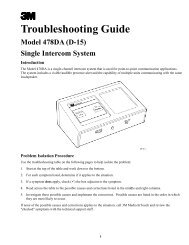HME system 20 drive-thru timer system operations manual.pdf
HME system 20 drive-thru timer system operations manual.pdf
HME system 20 drive-thru timer system operations manual.pdf
Create successful ePaper yourself
Turn your PDF publications into a flip-book with our unique Google optimized e-Paper software.
2. Time Measurement Definitions<br />
Time Event - Any <strong>drive</strong>-<strong>thru</strong> event or series of events for which time is measured.<br />
Types of time events:<br />
Menu-Board Time - The time measured from a vehicle’s arrival at the menu<br />
board or speaker post to its departure from that point.<br />
Greeting-Delay Time - The time measured from a vehicle’s arrival at the menu<br />
board or speaker post to the time the order taker begins greeting the customer<br />
through the audio <strong>system</strong>.<br />
Queue Time - The time measured from a vehicle’s departure from the menu<br />
board or speaker post to its arrival at the service window, or to its arrival at<br />
the cashier window (Scenario 3 only).<br />
Cashier-Window Time - The time measured from a vehicle’s arrival at the<br />
cashier’s window to its departure from that point (Scenario 3 only).<br />
Booth-Queue Time - The time measured from a vehicle’s departure from the<br />
cashier’s window to its arrival at the service window (Scenario 3 only).<br />
Service-Window Time - The time measured from a vehicle’s arrival at the<br />
service window to its departure from that point.<br />
Total Booth Time - The time measured from a vehicle’s arrival at the cashier<br />
window to its departure from the service window (Scenario 3 only).<br />
Total Time - The time measured from a vehicle’s arrival at the menu board<br />
or speaker post to its departure from the service window.<br />
Wait-Area Time - (Scenario 3 only) The time measured from a vehicle’s arrival<br />
at the wait area to its departure from the wait area.<br />
Target Time - The ideal time (in seconds) to serve a customer. The target time<br />
can be entered into the <strong>system</strong> for comparison with actual service times.<br />
Ideally, 70% - 75% of your customers should be served within this time.<br />
Excess Time - Time beyond the maximum amount of time a vehicle should be<br />
at a detection point, based upon time of day and business volume.<br />
Dayparts - Up to 24 time periods that you enter into the <strong>system</strong> to break the<br />
day into service times. Dayparts are referred to by numbers 1 through 24. Each<br />
daypart number begins with whatever time you choose, and ends automatically<br />
as the next daypart begins. Some periods usually represented as dayparts are:<br />
breakfast, mid-morning, lunch, mid-afternoon, dinner, evening, late night hours<br />
and hours closed.<br />
Detection Point - A location at which a measurement of time is taken. The<br />
four detection points typically used with the System <strong>20</strong>A are the menu board,<br />
cashier window, service window and waiting area.<br />
24-Hour Time - Time based on a 24-hour clock, stated from 0000 to 2359 hours.<br />
See Figure 3 on page 4 for examples.<br />
Repeat Period - The time (in seconds) between repeating alerts that occur after<br />
a vehicle has been at a detection point beyond the excess time.<br />
2
















